Catamaran For Sale By Owner – 2004 Maxim 38′ Catamaran
Location: Charleston, SC headed to Exumas Price: $180,000 REDUCED!
NO LONGER AVAILABLE ON FSBO!
Boat Information
Boat Name: Seabelle
Boat Model: Maxim 38′
Model Year: 2004
Current Use of Boat: Cruising
Condition: Ready to sail
Asking Price: $208,000
US Flag USCG registration #1273391
Dimensions
LOA: 38’
LWL 38’
Beam 20’
Draft 3’
Displacement 6000KG
SeaBelle is a 38’ Maxim built in South Africa. She is roomy 4 cabin dual head plan providing lots of bed space for guests. Much has been done to improve the original exterior design. We have improved the Bimini to a new hard top with opening sections for visibility, wench handling and great air movement. A full width hard windshield with folding lateral sections provides complete visibility. The rear of the boat has been re designed and rebuild to include a back deck large enough for lawn chairs and a dingy lift system on an over head davit making lifting the dingy a quick and easy operation. The dingy davit also serves to solidly hold 730 watts of solar power service by a new Outback solar controller. She is now US 120 V.
She is a light quick cat for her size with an easy sail plan and all lines including reefing lines coming to the cockpit enabling her for short handed sailing. Her three-foot draft allows easy passage in the ICW and the shallow areas of the Bahamas.
Her Yanmar motors are solid with 3200 hours. Sail drives replaced in 2016. The engine peripherals including raw water pumps, starter belts and hoses have been replaced in fall 2018. Heat exchangers were cleaned and pressure tested in fall 2018.
The Maxim’s original up galley and spacious settee, which collapses into a lounge area, sets it apart from other cats its size. Faucets and sink are new. Complete Dishes and cooking utensils included. Deep freeze and separate fridge allow provisioning for long passages and remote excursions.
The instrument package is a brand new fall 2018 Garmin system. The presentation of engine controls and instruments is mounted in smoked Plexiglas improving both its accessibility and style.
Many more details have been updated or replaced including LED lights inside and out, New heads, fresh paint, and so on. Plenty of the right spare parts. She has to be seen to understand that this is a boat you can climb on and go without worrying about immediate surprises.
Dimensions
LOA: 38’
LWL 38’
Beam 20’
Draft 3’
Displacement 6000KG
Extra Equipment
SeaBelle’s asking price includes the value of its optional equipment currently onboard added during the recent refit. While this is great stuff to have aboard, we are be happy to keep this equipment if the boat is delivered in the US. The optional equipment is brand new so we can discount its value:
- Rainman portable water maker 120V version $5000
- Honda 2000 generator $1000
- Engle Freezer $1000
- Yamaha 25 HP outboard $3000
Sails and Handling
The main sail and roller-furling jib were replaced in 2017 and didn’t appear to have been used much. The jib was stored in the cabin during the storm and was unaffected. The main was on the boom in its sail bag. Though the sail bag was torn it was not opened and the main did not suffer any damage. There were a few areas of red mangrove stains that have largely faded. On board are also an asymmetrical spinnaker and a storm jib. I have inspected these and found them to be stained but otherwise sound. They have not been raised by myself or the previous owner. though the spinnaker halyard is up and the lower spinnaker rigging is aboard.
SeaBelle is a quick and light cat to sail. She loves 15 to 20 kts. getting along at between 7 and 8 kts with the wind anywhere near the beam. She starts to slide with speeds under 3 kts if going up wind. Not bad for a shallow draft cat. I have been able to sail her very close to down wind by tying the jib to the aft pad eye and loosening the jib sheet. I have handled her in up to 30 kts. with 3 meter primary wave and 1.5 meter cross wave and although she pounds and seems to jump off the wave peaks she is very sound, rides through the trough without burying the bow and charges on. With heavy seas and strong winds the reefing system works beautifully with no need to leave the cockpit. She is truly a single hand capable boat if you you’ve got the nerve.
Motoring and Motor Sailing
I have moved her with a single engine at 2200 RPM’s at 4.5 kts day after day and also with both engines at 3000 RPM making 6.5 kts. The max RPM is ~ 3500 so depending on who you read 80% of that is sustainable. I have found 2600 to 2800 works best for me if I have a destination requiring timing. Motor-sailing she is also a very competent mover. With the main sheeted tight and the jib slot tuned she will add a knot or two even with winds under 6 kts. With 12 kts of favorable wind we generally make 6 kts or better and running a motor doesn’t add a great deal.
Keel
The 3 foot stated draft is probably a bit more than current actual as she is rigged very light right now. The keels provide great protection for the props and rudder with about 6 in difference. I’m told the bolts holding the solid keel are breakaway such that if you hit rocks hard they will break off without sinking the boat. The Keels are built to support the weight of the boat when on the hard or if you had to put her on a sand bar for emergency repairs.
Hurricane-Related Repairs
Bimini
The new hard top Bimini covers the full exterior cockpit adding several feet of width over the original design. Two opening panels fold back to give a view of the sail and room to work wenches and ropes. The lateral Bimini support encloses these workspaces eliminating the fear of falling. The new Bimini not only allows more covered space it is lighter and stronger due to its broader attachment base and its vacuum bagged epoxy core-cell construction. The walking bridge for boom access is twice as wide the original wood walk providing better safer boom access. The lateral windshield panels open to provide flexibility for good ventilation at warm anchorages or protection when moving in cold weather. Full side panels made of vinyl canvas with vinyl windows with flexible attachment points allows privacy and warmth or open sun-shading and ventilation or may even be pulled back to open the cockpit to the wide port-starboard and stern views without having to remove and reattach.
Stanchions and Navigation Lights
The original stanchion system terminated for and aft with seats and while this seemed cool in the beginning living with them proved less so. The aft seats took up much of the foot space on the rear of the hull. They were in the way while at the dock and when getting out of the dinghy from the side and the forward seats we never used since they were uncomfortable and they were in the way of getting to the forward cleat. These seats involved a lot of heavy stainless, created more wind-age and were just complicated so we simplified the stanchion mounts with heavy pad-eye terminations adding taller stanchion posts adjacent to the cockpit where you need them and left the bow and sterns cleaner. This has proven to be more to our liking despite the somewhat sexy photos advertisers use promoting those seats. We don’t visit the stern sugar scoops while off shore just on principal. “Man-overboard” is just something I never want to hear. However, a safety line can be strung from the aft stanchion to the dinghy lift.
Original port and starboard navigation lights were salvaged and remounted. The masthead light was undamaged but I did recondition all contacts. The stern light was replaced and mounted on the dinghy lift arch were it is unobstructed.
Port Window
The port side cabin window was replaced due to impact cracking in the storm. It never did leak.
Mid-ships Cleat and Hull Damage
Performed by Blue Water Yacht Services. This was the most glaring of the damage from Irma. The mid-ships cleat pulled off the cleat backing plate and some surface cloth. The original cleats were only attached to a backing plate and while this backing plate was replaced during the repair and the cleat bolts do thread to it we also decided to fully through bolt them for increased strength. While, if I were faced with a Irma level storm again I would simply lasso the hulls and not depend on cleats at all, these mid ship cleats are not coming off again. There were multiple areas of gel-coat scraping. They are undetectable now. The whole hull was polished and it now looks better than when we first saw it.
Major Refit
Beyond the hurricane related repairs, SeaBelle was built in 2004 and so it was time for a major refit.
Stern Platform
The rear walk which was originally wood and narrow, required a step down from the hull and was completely eclipsed by the dinghy rest when traveling closing access to the stern and forcing a climb out of the cockpit if bow access was required. It has now been completely redesigned and replaced. A wider epoxy core-cell deck raised even with the rear hulls is covered by the combined dinghy lift arch and solar array. The platform is split in two with the port side hinged. It lifts to reveal a storage area for dinghy gas and oil.
Dinghy Lift
The dinghy now lifts easily by hand with its triple pulley system and the dinghy rests slightly aft of its previous position maintaining easy walking across the stern while underway. The dinghy is further secured by supports that swing out and catch the dinghy bottom allowing it to be completely secured for rough seas. The old mast boom extension requiring use of the main halyard is still present and functional but we will never use it again. What was once a 20 min process of securing the dinghy for sea now takes a couple of minutes.
Dinghy
A 10’ large tube Highfield double-bottom aluminum RIB was purchased one year old in Tortola. It was mounted with a new 25 hp Yamaha Enduro with a 6 gal tank. Planning fins are mounted. The 25HP is a bit aggressive for a 10’ RIB but it planes well with 4 people and gear.
Solar
The original 200 watts of solar is now a six panel array. Two central 165 watt panels with 4 flanking 100watt panels are firmly held in the dinghy lift superstructure aft of boom shadowing and are wired to a new Outback solar controller. The port 200watts traverses 25 feet of 10 gage multi-strand copper while the starboard 530 watts travels in 25 feet of 8 gage multi-strand copper making her a truly off grid boat. The original extra house battery 65 amp alternators on each engine remain but now have a mounting system that allows them to be rested. In general, though we have found that they can still be useful while moving in winter when the sun may not be seen all week the solar will likely provide our power needs.
Instruments
The original Raymarine instrument set had seen its day and is now replaced with a complete Garmin set up indluding; GPSMap, sailpack VHF, AIS and autopilot. The wind vane is now wireless and works great every time without having to worry about that wire. The VHF is feasting on its new larger wire and whip antenna. We went with separating the VHF from the AIS unit preferring the redundancy. Send and receive AIS may be a bit much for a boat this size but it is reassuring. The dash instruments that were originally individually mounted are now all mounted in an attractive Plexiglas backing allowing easy access for inspection of the rear of all the instruments at the same time.
The Yanar key/tach panels were toast after so many years and while I considered buying new ones they still depend on a thin piece of plastic that provides the only weather proofing. Even though the whole of the instrument array is protected now by the bimini and windshield I decided to rebuild these panels with a more robust and matching Plexiglas front. The key units were replaced but the tachs are still good. The Plastimo magnetic compass I didn’t touch. It is solid.
Engines
SeaBelle’s two 3YM30 Yanmar diesels have been incredibly reliable and stable. The peripheral elements to the engine however had seen some questionable attention though the years. No one told me how to inspect an engine and buying this service doesn’t really tell you as much as you would like. Rounded bolts, zipties, paint over corrosion, non-Yanmar brand belts which therefore have the wrong pitch; these are things to look for and have all been addressed now. The water pumps were working fine but have now been rebuilt. The starboard pump is new not because I needed it but because you really should have a spare on board. The belts are now Yanmar. Changing these in open sea when they burn up because someone put the wrong ones on is no fun. The heat exchangers were serviced which means de-calcified and pressure tested. They were working fine but it is what you do. Also the hoses were replaced, the old ones are on board and although they look a little old they aren’t cracked and weren’t leaking. Hose clamps some of which were just hanging by one side have been replaced.
The challenge of the additional house alternator mounts that were added in Granada took some doing. The engine power seems to handle these well but the alignment and the additional torque on the engine mounts had become a problem requiring rebuilding the starboard outboard bracket and replacement of that engine mount. The tensioners on both sides have been replaced since they had cracked and the redesign facilitates taking them off line easily since she now has enough solar that they won’t be needed most of the time.
The starboard starter has been replaced and the old one stowed against an emergency. I had some advice that it ‘might’ have a weak solenoid but it actually turned out to be the magnetic key relay that has now been replaced. Due to the experience of having this go out we now also have a relay bypass switch on board.
While there wasn’t much corrosion on the engines I did clean them and repaint with Yanmar engine paint where needed.
Engine Rooms
The engine rooms themselves were dark and dirty. Now there is reflective heat and sound dampening along with extra lighting. These are the largest engine rooms I have encountered on a cat below 40’ and having them under the stern berths actually turned out to be of benefit because they are not out in the weather. The engines themselves didn’t seem to be affected at all by the Irma experience.
Sail drives
The previous owner replaced the SD30 sail drives in Granada in 2017. They do look new, but we lost a prop shaft seal bringing her to the Bahamas. At least the oil looked cloudy though when the oil drained there didn’t seem to be any free saltwater layered out. The fix there was an experience in learning that brand name part acquisition in the Bahamas is no fun. We ended up with a tractor seal as the only available seal with the needed diameters for the trip home. Surprisingly it did work. Now of course all four have been replace with new Yanmar seals and an extra set is stored aboard. There was no corrosion seen on the lower gears or housings during this rebuild. The aluminum props are in good shape. They were cleaned and repainted.
Electrical
Being a south African build SeaBelle still had her European 220 50 hz system. The old charger inverter therefore needed to be pulled. After consideration I decided to replace this with a straightforward true sine wave inverter of 2k watts. While tied up and when needed, before I put the solar on, I used a simple auto battery charger to maintain the batteries. Using a charger/inverter configuration instead of straight shore power may avoid some of the complicated galvanic bleed that can happen causing lots of damage and rapid zinc consumption while tied up. With the need for a wide slip or a T end dock living tied up is less likely for a Cat. So, at this point she doesn’t have a direct shore power system or a built-in battery charger. Adding a mounted charger would be a simple matter. The original wiring on the 220 side is 12 gage with 15amp circuit breakers. This has been adequate for our needs. You could run a small 1000watt microwave but we just haven’t needed it. Likewise although the true sine wave inverter would run an entertainment system easily in this day of Bluetooth music and watching video on our laptop we just haven’t felt the need.
Batteries
Six 6-volt gel cells are mounted under the settee cushions. They are 2.5 years old. They have been fully equalized and are performing well with the new solar input.
Plumbing
All faucets, plumbing connections and pumps have been gone through and largely replaced. A new stern shower was added in the center of the now accessible rear deck. The water heater was inspected and connections updated but the unit itself seems sound and is working very well.
Kitchen
Her ‘U’ shaped galley has proven to be very convenient with plenty of counter space. Both refrigerator and deep freeze have new controllers in 2017 and work well. The dual sinks have new faucets, fresh not and cold and salt water. The fresh water faucet rotates to serve both sinks for rinsing. Both sinks have corian covers. The kitchen sink was replaced and its attachment redesigned since getting access to the space under the sink proved very valuable. This is the location of the port holding tank and while you never want to have to access that it does happen. When it does you really need to be able to see what you are doing.
Propane 4-burner stove and oven are clean and working well.
Settee / Interior Dining
The dining table has been lowered and we use this area as a couch but it is a simple matter to raise it again. These supports are stored aboard. The outside cockpit table is comfortable for four. The cockpit cushions have been redone.
Cabins
SeaBelle’s four real berths have four inches of relatively firm foam. This was originally encased in fabric that had become old and salt impregnated so it has mostly been removed and not replaced. For us the foam is more manageable exposed. While we have considered dressing up the bedrooms with wood or panel she is a light and quick boat now. We haven’t thought this was the direction we wanted to go. She is easy to clean and keep straight as she is. There is also foam for the forward coffin berths aboard but one has been cut in half for the settee couch center.
Heads and Interior Showers
The two heads have new pumps faucets and showerheads. I went with good quality but plastic faucets and knobs since metal is just harder to maintain. They are now top down mounted as under sink mounting in this small compartment was no fun to work on. The head and shower is in the same space allowing more elbowroom than a separate enclosure. I have felt this is a good layout to live with on a 38 footer.
Storage
SeaBelle has absolutely tons of storage space. So much so that unloading her has been a major project. The previous owner told me that he removed over 1000 lb from the forward areas and under berth compartments and I believe him. The under settee area adds to kitchen space and the cockpit also has huge storage areas. She sits high on the water line as she is especially light now since the rebuild took off additional weight. The current waterline was established when she was loaded down and is the reason it is a bit bow high.
Bottom Paint
When we purchased her the bottom paint was supposed to be 6 months old and although she had very little growth when we pulled her out in Great Exuma the paint had clearly worn through. Sea Hawk Island 44 was applied at that time by the marina but it had worn through again when she was pulled in Wanchese 6 months later. I was surprised to see this after only 6 months. Regardless, we re-did the bottom again in Wanchese and this time I witnessed or applied it myself so I am sure of how much went on. We used a compatible Sea Hawk 44 designed to bond over the Island 44, which isn’t available in the US.
Life Raft & Emergency Equipment
New flares are aboard, but the 8 person life raft is way out of date. It is aboard and probably works, but no value has been added for this. I would not depend on it as is.
A condition and value survey was done immediately after repairs were completed and is available upon request.
Wire nuts in redoing the navigation lights and solar areas I used wire nuts with corrosion prevention conductive grease. The USCG specifies hard crimp connectors does not recommend this. While I can see this in some situations many of the wires in SeaBelle are approaching being too short and cutting off connectors every time you have to trouble shoot something makes the situation worse. Living on the NC outer banks I have used this wire nut corrosion prevention combination for many years now and I have never had to replace a connection due to corrosion, loss of conductivity or even loosening. The surveyor commented that he sees this a lot and doesn’t think it is unusual or poor but felt he had to comment since it is not the USCG’s recommendation.
Maxim 38 Specifications
Dimensions
LOA: 38’
LWL 38’
Beam 20’
Draft 3’
Displacement 6000KG
Tankage
Fuel 600L in 2 Stainless Tanks
Water 600L in 2 Stainless Tanks
Holding tanks 50L 2 fiberglass tanks.
Sails and Rig
Fully battened Mainsail (New 2017)
Furling genoa (New 2017)
Harken Bat Car System for Main (New 2017)
Asymmetrical Spinnaker
Storm Jib
Profurl Genoa Furler
Spar craft 17m Double spreader mast
Custom sail bag with lazy-jacks
Dinghy davit supplants Telescopic boom derrick for lifing tender
All running rigging comes to cockpit for eash short-handed sailing.
Accomodations
4 double cabins (2 queen forward and 2 double aft)
All cabins have hatch with screen and shade.
2 heads with showers
Forward cabin have additional single bow berth
GRP interior with solid wood trim, light ary, easy maintenance.
Corian main cabin work surfaces
Salon upholstery (new 2017)
Wood salon table so seat 8 which can be converted to couch or double bed
Lots of under seat storage
6 cabinets
4 hanging lockers
Aft facing navigation station
LED lighting salon (new 2018) florescent lighting in cabins.
Isotherm 50L stainless water heater, using port engine heat.
Galley
Coolmatic fridge
Coolmatic top loading fridge/freezer
Stailess steel sink (new 2018)
Second drying sink with separate drain
Stainless faucets fresh and salt water. (new 2018)
4 burner SMEV stove
SMEV oven (propane sensor behind stove new 2018)
Corian counter tops
Electronics
Garmin GPS MAP xs 940 with built in Blue water chart US and Bahamas (new 2018)
Garmin Sail pack, wind depth speed and water temp. (new 2018)
Garmin Mast head wind instrument wireless. (new 2018)
Garmin Auto pilot computer and display (new 2018) chain driven motor original.
Garmin 100 VHF radio (new 2017) Wire and masthead whip (new 2018)
Garmin AIS send/receive utilizing independent GPS sensor (new 2018)
Plastimo 130 compass
Mechanical and Electrical
2 x 165 W Renogy panels (new 2018)
4 x 100 W Renogy panels (new 2017)
Outback solar regulator (new 2018)
2 60 AMP house alternators (the listed 110 amp alternators not actual at previous listing that I can tell)
House Battery bank 6 x 6V 200AH (new 2017)
110 V 2000W True sine wave inverter (new 2018)
110 outlets
Link 2000 Zantrex battery monitoring system
On Deck
Full cockpit coverage Hard Bimini with non slip boom walk(new 2018)
Large opening bimini panels for winch work with lateral safety rail(new 2018)
Full windshield Optix plex Lateral segments opening. (new 2018)
Full surround side and rear vinyl panels with clear vinyl windows. (new 2018)
3 Andersen self-tailing winches (two main winches rebuilt 2018)
Cockpit table
Cockpit cushions (recovered 2018 blue sunbrella with white piping)
3 large cockpit lockers
Cockpit propane tank locker 2 x 20 lb fiberglass tanks
Cockpit under floor locker
2 large forward deck storage lockers
Stainless propane Grill
Hot and cold shower middle of rear deck (new 2018)
Port sugar scoop shower
Rocna 25kg primary anchor with 150 ft of chain
Lofrans Cayman 80 windlass (new 2013)
Grey webbing trampolines
8 fenders
Dock lines
8 Lewmar deck hatches
Salt water deck wash
Dinghy
10 foot large balloon Highfield double bottom aluminum RIB (2016)
25 HP Yamaha enduro with planeing fins(new 2017)
6 liter gas tank
Safety
4 self-inflating life jackets
3 children’s life hackets
4 adult life jackets
Drogue
Ditch bag with new flares
2 manual bilge pumps
4 electric bilge pumps
Emergency tiller
Fog horn
2004 Maxim 38′ Catamaran Pictures
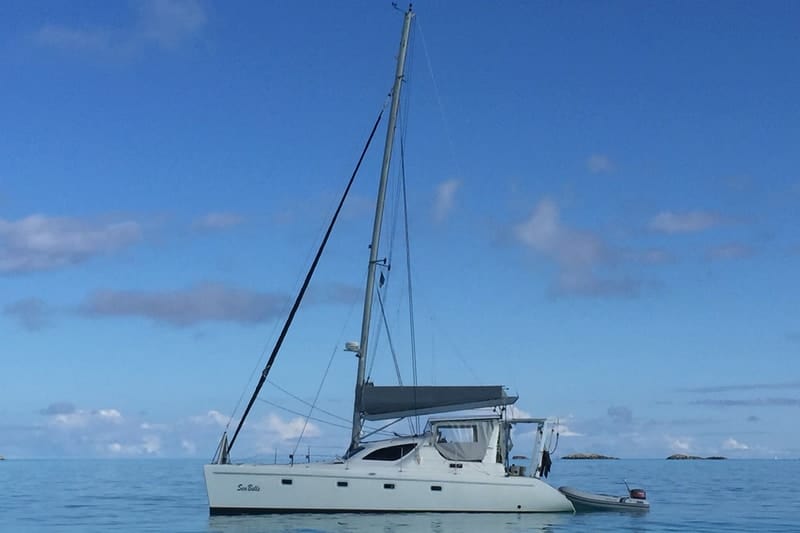 |
 |
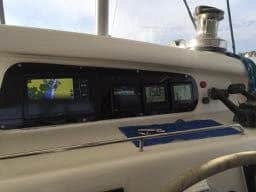 |
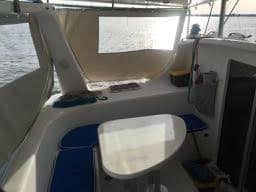 |
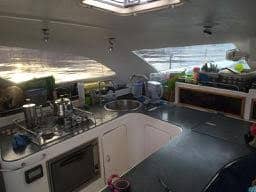 |
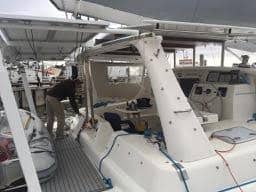 |
 |
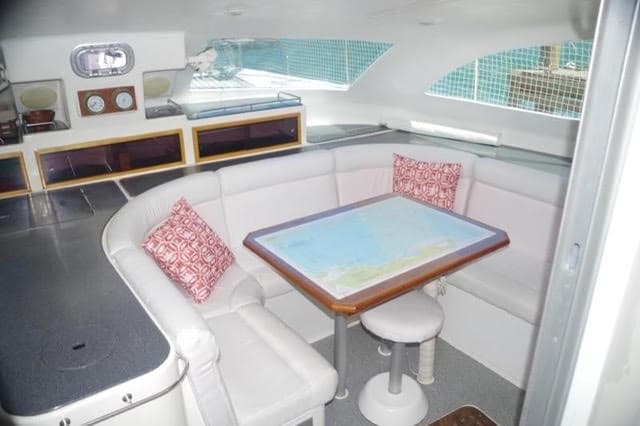 |
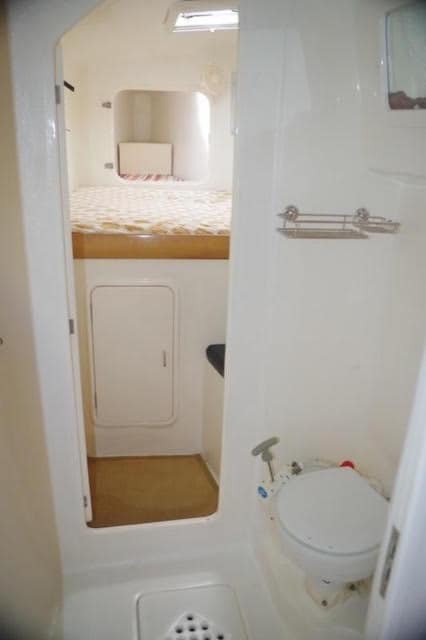 |
 |
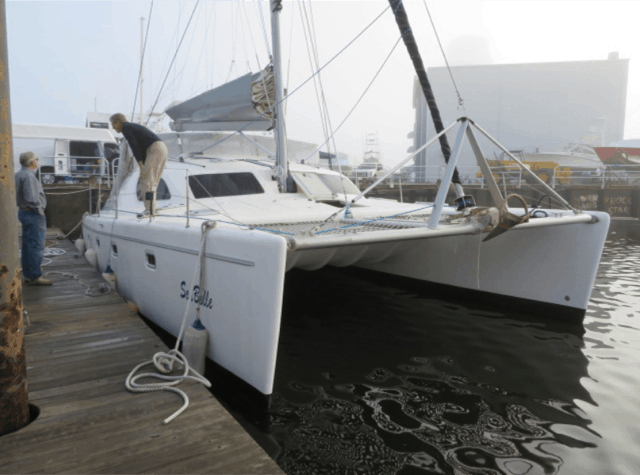 |
Disclaimer: Our “For Sale By Owner” (FSBO) Listings are published purely as an additional service to Catamaran Guru readership. Catamaran Guru does not act as the broker in these transactions. Catamaran Guru is not responsible for the accuracy of the listings and has no control over responsiveness or lack thereof from the boat owners.






